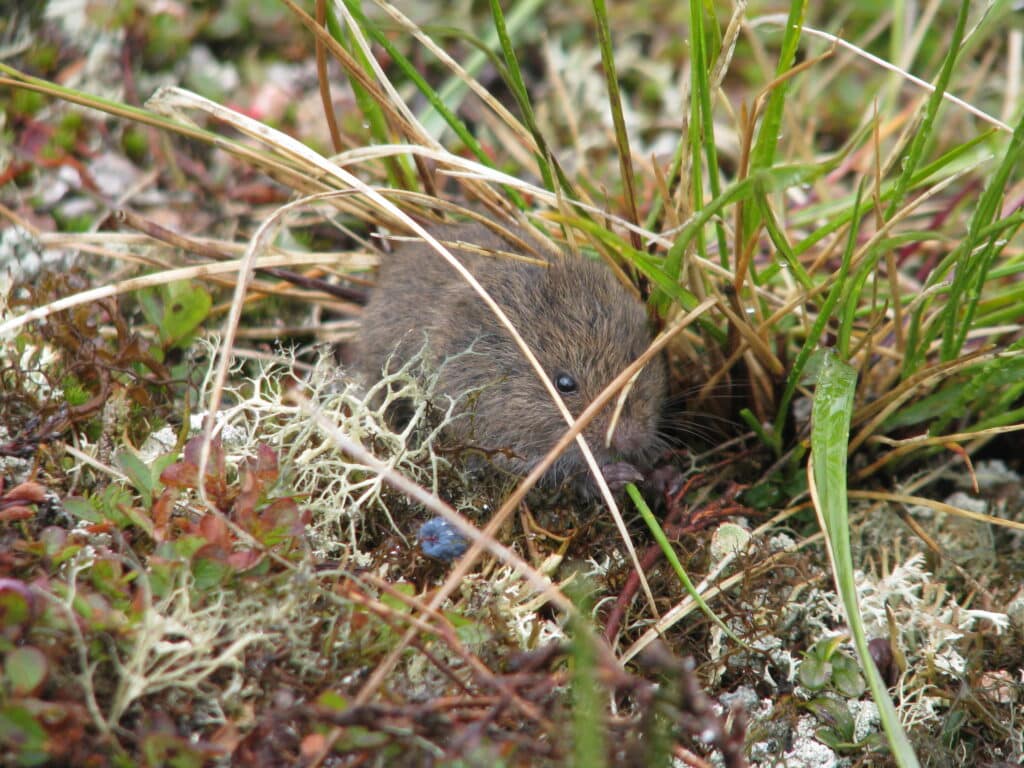
Moose, wolf, and bears are icons of canoe country, but many species of mammals are almost entirely unknown and unseen, including the elusive Northern Bog Lemming.
The Northern Bog Lemming (Synaptomys borealis) is rarely spotted by all but the most dedicated scientists. It’s listed as a species of “special concern” by the Minnesota Department of Natural Resources, living in small, isolated communities and depending on specific habitat. The federal government will consider listing it as endangered or threatened in 2022.
While more widespread in Canada, this small rodent only occupies the northern reaches of Minnesota, earning them state designation as fragile parts of the ecosystem. Intensive efforts to document its distribution have only turned up a handful of specimens across the region. They are also found sporadically in Maine, New Hampshire, Montana, and Idaho.
Bog, sweet bog
Northern Bog Lemmings love peatlands and swamps. The species was first found in Minnesota in Lake of the Woods County in 1932. Over the intervening years, fewer than a dozen specimens have been documented in the state, in Roseau, Clearwater, Beltrami, Koochiching, Itasca, and St. Louis counties.
The lemmings are small, averaging about five-and-a-half inches long, with a stumpy tail. Their fur is “grizzled grayish brown” with an orange patch at the base of the ear.
They are essentially a creature stranded by its ancestors. During the last glacial advance, they are believed to have lived as far south as Kansas. When the glaciers retreated, some populations survived in isolated bogs, surrounded by inhabitable landscapes. In Montana and Idaho, the creatures hang on in peatlands more than 60 miles from the unbroken bogs of Canada.
“The northern bog lemming may be a relic species whose present distribution, particularly in Montana, reflects the glacial history of this region. Forced to migrate southward as the Pinedale Glacial advance occurred (18,000-10,000 years before present), the northern bog lemming, through its habitat preferences, established itself in the boreal climate of the time. As the glacial mass re-ceded northward over the past 10,000 years small northern bog lemming populations remained behind, ultimately becoming trapped in islands of boreal (bog) habitat as broader habitat changes occurred.”
– The wild mammals of Montana, by Foresman, Kerry Ryan; American Society of Mammalogists
The small animals mostly eat vegetation like grasses and sedges, although they will also eat snails, slugs, and other small creatures. Northern Bog Lemmings typically live in open, wet habitats dominated by sphagnum moss, shrubs like bearberry, wintergreen, Labrador tea, and grasses and sedges. Even if the animal itself is not seen, a sharp-eyed observer might still see evidence of their presence: small piles of clipped vegetation and bright green scat mark their territory.
The little lemmings live in burrows and nests either underground or under stumps or logs, in a colony with others of their kind. They also build and maintain “runways” through the vegetation, clipping vegetation to line the routes. The creatures stay active day and night and all year long, with secretive habits intended to avoid predators like hawks and weasels.
Harbinger of climate harms
Northern Bog Lemmings closely resemble the southern bog lemming (S. cooperi), which is more common. Both species can be found at the same location, but they are distinct. Species confirmation requires examining dental and skull characteristics. The population is believed to rise and fall rapidly and cyclically, based on environmental conditions. Northern Bog Lemmings breed between May and August, with gestation lasting three weeks and an average of four young per litter. Females are capable of breeding again one day after giving birth, and the animals reach reproductive age at just five to six weeks. Females can have three or four litters in a season, which lets the population grow quickly in good conditions.
Northern Bog Lemmings are threatened by habitat loss from timber and peat harvest, climate change’s effects on their ecosystem, and their own isolated instances into the United States. In 2015, the organization WildEarth Guardians submitted a petition to the U.S. Fish and Wildlife Service (USFWS) requesting consideration of listing the lemmings as federally threatened or endangered.
“Bog lemmings are a harbinger of the impacts of climate change in the United States,” said Taylor Jones, endangered species advocate for WildEarth Guardians. “Uniquely adapted to already rare imperiled habitats, the species needs the protections of the Endangered Species Act to survive and recover.”
The USFWS reviewed the petition and found sufficient evidence to warrant a full study of the species status. The emphasis is on a subspecies found in Maine and New Hampshire, but the population across the northern United States will be evaluated. The agency plans to conduct that review next year.
More information:
- Synaptomys borealis – Minnesota DNR
- Synaptomys borealis – Animal Diversity Web – University of Michigan
- Imperiled by Climate Change, Rare Northern Bog Lemming Needs Protections – WildEarth Guardians
- Petition to List the Northern Bog Lemming (Synaptomys borealis) Under the U.S. Endangered Species Act – WildEarth Guardians (PDF)

